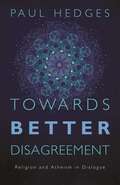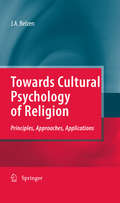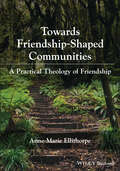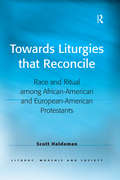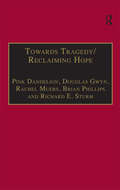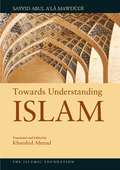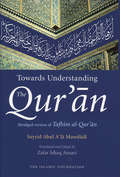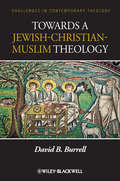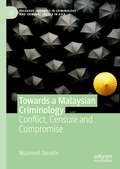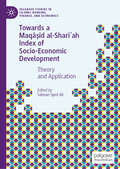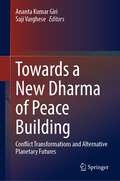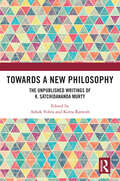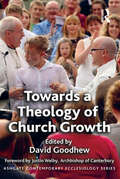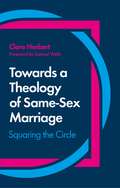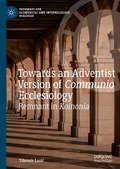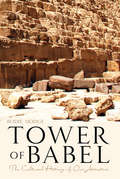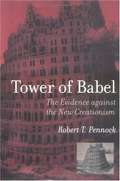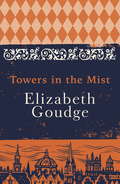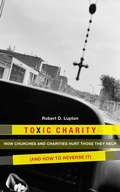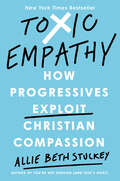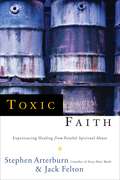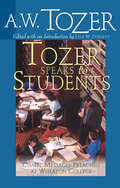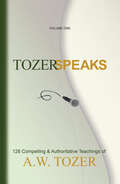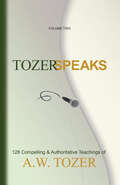- Table View
- List View
Towards Better Disagreement: Religion and Atheism in Dialogue
by Paul HedgesAre atheists immoral? Does religion cause conflict? Is religion always opposed to science? Boldly paving the way for constructive dialogue between atheists and religious believers, Paul Hedges tackles issues such as the treatment of women, the idea of a pure and empirical realm of 'science', and the association of religion with violence and warfare, debunking the myths and exposing the futility of the battle between 'reason' and 'belief'. Threading deftly between atheism, the major world religions of Christianity, Islam and Buddhism, and smaller groups such as Paganism, Hedges demonstrates a vast scope for agreement and interaction between them which will call to every open minded reader.
Towards Cultural Psychology of Religion
by Jacob A. BelzenThis book takes a bold stand: all psychology should be culturally sensitive psychology, especially when studying religious phenomena. It explains that culture is not simply to be conceived of as a variable that possibly influences behavior. Rather, it stresses that cultural patterns of acting, thinking and experiencing are created, adopted and promulgated by a number of individuals jointly. As human subjectivity is different in different cultures, cultural psychology is not interested in comparatively investigating how experiences and behavior, attitudes and social relationships present themselves within different cultural conditions. By consequence, cultural psychology does not start from Western psychological constructs, testing for their presence in other cultures, but from human acts and activities in specific cultures, analyzing them in a hermeneutical way. Like cultural psychology, psychology of religion currently enjoys more and more interest and rapid growth. But the two fields have remained rather unconnected in the recent past. Psychological research on religion has been pursued from a number of perspectives, among which a cultural psychological one has not yet become prominent. As religions, however conceptualized, are cultural entities of major importance, cultural psychology seems a natural ally to research on religion. Containing a number of studies, both theoretical and empirical, this volume takes a step towards a rapprochement of cultural psychology and psychology of religion.
Towards Friendship-Shaped Communities: A Practical Theology of Friendship
by Anne-Marie EllithorpeA unique and incisive exploration of the place and nature of friendship in both its personal and civic dimensions In Towards Friendship-Shaped Communities: A Practical Theology of Friendship, distinguished theological researcher Anne-Marie Ellithorpe delivers a constructive and insightful exploration of the place and nature of friendship as innate to being human, to the human vocation, and to life within the broader community. Of particular interest to members and leaders of faith communities, this book responds to contemporary concerns regarding relationality and offers a comprehensive theology of friendship. The author provides an inclusive and interdisciplinary study that brings previous traditions and texts into dialogue with contemporary contexts and concerns, including examples from Indigenous and Euro-Western cultures. Readers will reflect on the theology of friendship and the interrelationship between friendship and community, think critically about their own social and theological imagination, and develop an integrative approach to theological reflection that draws on Don Browning’s Fundamental Practical Theology. Integrating philosophical, anthropological, and theological perspectives on the study of friendship, this book presents: A thorough introduction to contemporary questions on friendship and discussions of co-existing friendship worlds Comprehensive explorations of friendship in first and second testament writings, as well as friendship within classical and Christian traditions Practical discussions of theology, friendship, and the social imagination, including explorations of mutuality and spirit-shaped friendships Considerations for outworking friendship ideals within communities of practice, from the perspective of strategic (or fully) practical theology Perfect for graduate and advanced undergraduate students taking courses on friendship or practical theology, Towards Friendship-Shaped Communities: A Practical Theology of Friendship will also earn a place in the libraries of scholars of practical theology and community practitioners, including ministers, priests, pastors, spiritual advisors, and counselors.
Towards Liturgies that Reconcile: Race and Ritual among African-American and European-American Protestants (Liturgy, Worship and Society Series)
by Scott HaldemanTowards Liturgies that Reconcile reflects upon Christian worship as it is shaped, and mis-shaped, by human prejudice, specifically by racism. African Americans and European Americans have lived together for 400 years on the continent of North America, but they have done so as slave and master, outsider and insider, oppressed and oppressor. Scott Haldeman traces the development of Protestant worship among whites and blacks, showing that the following exist in tension: African American and European American Protestant liturgical traditions are both interdependent and distinct; and that multicultural communities must both understand and celebrate the uniqueness of various member groups while also accepting the risk and possibility of praying themselves into an integrated body, one new culture.
Towards Tragedy/Reclaiming Hope: Literature, Theology and Sociology in Conversation
by Pink Dandelion Rachel Muers Brian Phillips Douglas GwynThe 'death of tragedy' in the modern era has been proposed and debated in recent years, largely in terms of literature and western culture in general. Today, any catastrophe or misadventure is likely to be labeled a 'tragedy', without any inference of a larger, transcendent horizon or providential design that the word once conveyed. This book offers new perspectives on the idea of the 'death of tragedy', taking England and the Religious Society of Friends (Quakers) in particular as a case study. Chapters focus on the origins of tragedy in ancient Greece, gospel and tragedy, the beginnings of the Quaker movement in seventeenth-century England, apocalyptic versus secularized experiences of time, Edwardian Quaker triumphalism, the search for English identity in postcolonial Britain, liberal Quakerism at the end of the twentieth century, and the promise and dilemma of postmodernity. The different disciplinary perspectives of the contributing authors bring literature, history, theology and sociology into a creative and revealing conversation. A Foreword by Richard Fenn introduces the book with an original and provocative meditation on tragedy and time.
Towards Understanding Islam
by Sayyid Abul MawdudiTowards Understanding Islam is a religious text with a difference. It offers a simple exposition of the essential teachings of Islam: its approach to life, the articles of its faith, its scheme of worship and prayers, and the social order that it envisages.
Towards Understanding the Qur'an: English Only Edition
by Sayyid Abul Mawdudi Zafar Ishaq AnsariAn immense understanding of the Qur'an is offered here, a vast treasure of knowledge and deep insight and a valuable exposition of some social, political, economic and legal teachings of the Qur'an. But what makes this work unique is that it presents the Qur'an as a book to be lived by. With thousands of notes, an introduction and comprehensive index.
Towards a Jewish-Christian-Muslim Theology (Challenges In Contemporary Theology Ser. #28)
by David B. BurrellTowards a Jewish-Christian-Muslim Theology delineates the ways that Christianity, Islam, and the Jewish tradition have moved towards each another over the centuries and points to new pathways for contemporary theological work. Explores the development of the three Abrahamic traditions, brilliantly showing the way in which they have struggled with similar issues over the centuries Shows how the approach of each tradition can be used comparatively by the other traditions to illuminate and develop their own thinking Written by a renowned writer in philosophical theology, widely acclaimed for his comparative thinking on Jewish and Islamic theology A very timely book which moves forward the discussion at a period of intense inter-religious dialogue
Towards a Malaysian Criminology: Conflict, Censure and Compromise (Palgrave Advances in Criminology and Criminal Justice in Asia)
by Muzammil QuraishiThis book provides a critical analysis of criminological scholarship in Malaysia, presenting a focused exploration of the key qualities and limitations to studies on crime, deviance, victimization and criminal justice in this country. This text connects contemporary crime problems with historical legacies such as the impact of colonialism and the influence of ethno-nationalism and authoritarianism in the region. Conflict and tension created by legal pluralism is illustrated via three case studies exploring apostasy, Islamic rehabilitation centres, and retention and use of the death penalty. In addition to a critique of contemporary Malaysian criminological scholarship, Towards a Malaysian Criminology suggests a composite, critical criminological approach to guide future research. This approach draws on theoretical traditions in critical race theory, critical realism, ultra-realism and the emerging field of Islamic critical realism. Given the multidisciplinary nature of the discipline, this text will appeal to scholars of criminology, sociology, law, politics and Islamic theology.
Towards a Maqāṣid al-Sharīʿah Index of Socio-Economic Development: Theory and Application (Palgrave Studies in Islamic Banking, Finance, and Economics)
by Salman Syed AliIslamic economics, which is a discipline for studying economic behaviour from an Islamic perspective, advocates comprehensive human development defined by advancement and progress in multiple dimensions beyond GDP, income, or standard of living. Not only should socio-economic progress be in all dimensions but it should also have a higher purpose. A society is considered economically and socially developed if adequate protections are provided for faith, life, intellect, progeny, and wealth. This concept of balanced progress itself is an important idea recognized by the sociologists. However, the same has so far not been measured or used in policy making by economists. Similarly, lack of adequate protections in a society along these dimensions indicates poverty which is another way of measuring slack in development. The chapters in this edited volume deal with conceptualization of socio-economic development on these lines, and show how to measure socio-economic development in a comprehensive way. The book will be of interest to academics in the fields of economics, economic development, and Islamic economics. It will also be of interest to policy makers engaged in economic development, social progress, and poverty alleviation.
Towards a New Dharma of Peace Building: Conflict Transformations and Alternative Planetary Futures
by Ananta Kumar Giri Saji VargheseThis volume deals with a new Dharma of peacebuilding and conflict transformations, drawing on the world's philosophical, religious, and spiritual traditions and many recent initiatives and experiments with peace. It deals with issues of sustainable peace, Dharma and Ubuntu of peace from African traditions, neurological insights of peacebuilding, traditions of conscientious objection, Satyagraha, possibilities of Gandhian Ahimsa, and moral and ethical limits of conflict and conflict resolution. It also presents the works of peace thinkers and activists such as Spinoza, Abhinavagupta, Tolstoy, Gandhi, Ulrich Beck, and others. It offers new initiatives and experiments in peace in different parts of the world—Palestine-Israel, Colombia, the Middle East, India, and South Africa. This pioneering and handy book is of interest to students, scholars, teachers, and activists working in peace and conflict studies, development studies, cultural studies, and religious studies as well as in different civil society organizations around the world.
Towards a New Philosophy: The Unpublished Writings of K. Satchidananda Murty
by Ashok Vohra and Kotta RameshK. Satchidananda Murty (1924-2011) was a vociferous writer and an iconoclast. This volume is a collection of his unpublished writings It presents Murty's unpublished keynote addresses, papers presented in seminars, and lectures which show his reflections and arguments in contrast to contemporary philosophers with regard to recent developments in philosophy. The writings reveal Murty's rejection of established theories by well-known eastern and western philosophers, as well as his arguments in their support, and present a new interpretation of their contention in the contemporary idiom. Murty critically evaluates the contemporary arguments of Malcolm, James Ross, Alvin Plantinga, Charles Hawthorne, Jean-Paul Sartre, Anthony Flew, E.H. Madden, and P.H. Hare. An important contribution, the book assesses K. Satchidananda Murty's contribution to philosophy during sixty-one years of his engagement with active writing and teaching. It will be of great interest to scholars, teachers, and students of Indian philosophy, Hindu philosophy, Vedāntic philosophy, Advaita Vedānta, comparative philosophy, religious studies, and South Asian studies.
Towards a Theology of Church Growth (Routledge Contemporary Ecclesiology)
by David GoodhewConcern about church growth and decline is widespread and contentious, yet theological reflection on church growth is scarce. Reflecting on the Bible, dogmatic theology and church history, this book situates the numerical growth of the church within wider Christian theology. Leading international scholars, including Alister McGrath, Benedicta Ward and C. Kavin Rowe, contribute a spectrum of voices from evangelical, charismatic, liberal and anglo-catholic perspectives. All contributors unite around the importance of seeking church growth, provided this is situated within a nuanced theological framework. This book offers a critique of ’decline theology’, which has been influential amongst theologians and churches, and which assumes church growth is impossible and/or unnecessary. The contributors provide rich resources from scripture, doctrine and tradition, to underpin action to promote church growth and to stimulate further theological reflection on the subject. The Archbishop of Canterbury provides the Foreword.
Towards a Theology of Same-Sex Marriage: Squaring the Circle
by Clare HerbertA transformative exploration of queer theology and the debate around same-sex marriage within the Church. Clare Herbert draws on her experience as a priest within the Church of England in a committed same-sex relationship and considers the questions that have shaped religious debate for many years. This book explores the concept of same-sex marriage in relation to the heteronormative definition of marriage, and its effect on past understandings of the sacrament. Interweaving stories from Christians struggling to reconcile their faith with their sexuality alongside wider queer theology and the theology of marriage, Herbert explores the unique understanding of God provided by the experience of committed same-sex love , and lays the groundwork for redefining the traditional definition of marriage.
Towards an Adventist Version of Communio Ecclesiology: Remnant in Koinonia (Pathways for Ecumenical and Interreligious Dialogue)
by Tihomir LazićThis book explores how Seventh-day Adventists, like other Christians, can benefit from generating their own version of communio ecclesiology. It starts by offering a critical analysis of the status quo of the existing Adventist portrayal of church as remnant, and suggests potential ways of moving this tradition forward. To articulate a more rounded and comprehensive vision of the church’s rich and multifaceted relational nature, this book draws on the mainstream Christian koinonia-based framework. Consequently, it provides possible solutions to some of the most divisive ecclesial issues that Christian communities face today regarding church structure, ministry, mission, communal interpretation, and reform. As it sets on a new footing the conversation between Adventism and other mainstream Christian traditions, the methodology of this book serves as a pathway for any Christian community to use when revisiting and enhancing its own current theologies of the church.
Tower of Babel: The Cultural History of Our Ancestors
by Bodie HodgeThe Tower of Babel: The Cultural History of Our Ancestors reveals our shared ancestry as never before! Many are familiar with the Biblical account of Babel, but after the dispersal, there was a void beyond Biblical history until empires like Rome and Greece arose. Now, discover the truth of these people groups and their civilizations that spread across the earth and trace their roots back to Babel as well as to the sons and grandsons of Noah. Many of today’s scholars write off what occurred at the Tower of Babel as mythology and deny that it was a historical event. Beginning with the Biblical accounts, author Bodie Hodge researched ancient texts, critical clues, and rare historic records to help solve the mystery of what became of the failed builders of Babel. For the purpose of defending the Bible, Hodge presents these and other vital historical facts surrounding this much-debated event. Teens and older can use this layman’s reference for Biblical classes, ancient history, apologetics training, and to realize their own cultural connection to the Bible. A speaker and researcher for Answers in Genesis, Bodie Hodge is known for his contribution to and authoring of other Christian apologetics titles including: Begin Fall of Satan Answers Books Series How Do We Know the Bible is True Vol 1 & 2 Demolishing Supposed Bible Contradictions Series
Tower of Babel: The Evidence Against the New Creationism
by Robert T. PennockFinalist in the ForeWord Magazine Book of the Year Awards. Creationism is no longer the simple notion it once was taken to be. Its new advocates have become more sophisticated in how they present their views, speaking of "intelligent design" rather than "creation science" and aiming their arguments against the naturalistic philosophical method that underlies science, proposing to replace it with a "theistic science." The creationism controversy is not just about the status of Darwinian evolution--it is a clash of religious and philosophical worldviews, for a common underlying fear among Creationists is that evolution undermines both the basis of morality as they understand it and the possibility of purpose in life. In Tower of Babel, philosopher Robert T. Pennock compares the views of the new creationists with those of the old and reveals the insubstantiality of their arguments. One of Pennock's major innovations is to turn from biological evolution to the less charged subject of linguistic evolution, which has strong theoretical parallels with biological evolution, both in content and in the sort of evidence scientists use to draw conclusions about origins. Of course, an evolutionary view of language does conflict with the Bible, which says that God created the variety of languages at one time as punishment for the Tower of Babel. Several chapters deal with the work of Phillip Johnson, a highly influential leader of the new Creationists. Against his and other views, Pennock explains how science uses naturalism and discusses the relationship between factual and moral issues in the creationism-evolution controversy. The book also includes a discussion of Darwin's own shift from creationist to evolutionist and an extended argument for keeping private religious beliefs separate from public scientific knowledge.
Towers in the Mist: The Cathedral Trilogy
by Elizabeth GoudgeAn enchanting story of hope and fulfilment, set amid the Oxford colleges.Set in Elizabethan times, Faithful, a poor Londoner, heads for Oxford. He's bright, cheeky and good-looking, has a tremendous love of learning and hopes to be an Oxford scholar. When he is taken in by Canon Leigh and his family, Faithful begins to fulfil his dreams. In this coming-of-age tale, the excitement, squalor and beauty of the English Renaissance unfolds through the lives of two girls growing up, Oxford students approaching the threshold of distinguished careers, and their elders navigating the complicated waters of sixteenth-century England.What readers are saying about TOWERS IN THE MIST'A delight' - 5 STARS'One of the best' - 5 STARS'Brimming with life and charm; - 5 STARS'Absolutely magical' - 5 STARS'A novel which deserves to be read more than once' - 5 STARS
Toxic Charity: How the Church Hurts Those They Help and How to Reverse It
by Robert D. LuptonPublic service is a way of life for Americans; giving is a part of our national character. But compassionate instincts and generous spirits aren't enough, says veteran urban activist Robert D. Lupton. In this groundbreaking guide, he reveals the disturbing truth about charity: all too much of it has become toxic, devastating to the very people it's meant to help. In his four decades of urban ministry, Lupton has experienced firsthand how our good intentions can have unintended, dire consequences. Our free food and clothing distribution encourages ever-growing handout lines, diminishing the dignity of the poor while increasing their dependency. We converge on inner-city neighborhoods to plant flowers and pick up trash, battering the pride of residents who have the capacity (and responsibility) to beautify their own environment. We fly off on mission trips to poverty-stricken villages, hearts full of pity and suitcases bulging with giveaways-trips that one Nicaraguan leader describes as effective only in "turning my people into beggars." In Toxic Charity, Lupton urges individuals, churches, and organizations to step away from these spontaneous, often destructive acts of compassion toward thoughtful paths to community development. He delivers proven strategies for moving from toxic charity to transformative charity. Proposing a powerful "Oath for Compassionate Service" and spotlighting real-life examples of people serving not just with their hearts but with proven strategies and tested tactics, Lupton offers all the tools and inspiration we need to develop healthy, community-driven programs that produce deep, measurable, and lasting change. Everyone who volunteers or donates to charity needs to wrestle with this book.
Toxic Empathy: How Progressives Exploit Christian Compassion
by null Allie Beth StuckeyA sharp Christian voice makes a bold argument: when politics are driven by empathy rather than truth, innocent people pay the price. We are told that empathy is the highest virtue—the key to being a good person. Is that true? Or has “empathy,” like so many other words of our day—“tolerance,” “justice,” “acceptance”—been hijacked by bad actors who exploit compassion for their own political ends? In Toxic Empathy, Allie Beth Stuckey argues that empathy has become a tool of manipulation by left-wing activists who bully people into believing that they must adopt progressive positions to be loving. She explores the five most heated issues through which toxic empathy is deployed: abortion, gender, sexuality, immigration, and social justice. Progressives use catchy mantras to present their perspective as empathetic, like “abortion is healthcare,” “love is love,” or “no human being is illegal,” but in each case, they ignore the other side of the moral equation. For example, abortion is presented as compassionate for the woman, but what about the human life the procedure kills? This book isn’t about killing empathy; it’s about submitting our empathy to God’s definitions of love, goodness, and justice. Stuckey exposes the logical pitfalls and moral consequences of toxic empathy, equipping Christians with research-backed, Biblical truths to dismantle the progressive lies that have permeated our culture—and our church. <br><b>New York Times Bestseller</b></br>
Toxic Faith: Experiencing Healing Over Painful Spiritual Abuse
by Stephen Arterburn Jack FeltonWhen religion becomes a means to avoid or control life, it becomes toxic. Those who possess a toxic faith have stepped across the line from a balanced perspective of God to an unbalanced faith in a weak, powerless or uncaring God. They seek a God to fix every mess, prevent every hurt, and mend every conflict.<P> Toxic Faith distinguishes between a healthy faith and a misguided religiosity that traps believers in an addictive practice of religion. It shows how unbalanced ministries, misguided churches, and unscrupulous leaders can lead their followers away from God and into a desolate experience of religion that drives many to despair. Toxic Faith shows readers how to find hope for a return to genuine, healthy faith that can add meaning to life. In the words of the author, "I want to help you throw out that toxic faith and bring you back to the real thing."From the Trade Paperback edition.
Tozer Speaks to Students: Chapel Messages Preached at Wheaton College
by A. W. TozerExcept for C. S. Lewis and Oswald Chambers, it is difficult to find a 20th-century Protestant author who has a wider audience than Tozer. With more than 3 million books in print, the works of Tozer find their place on library shelves literally around the world. However, it is less well-known that Tozer had a particularly profound impact on college students. This volume consists of never-before-published chapel messages and sermons preached during 1952 and 1954 at Wheaton College. "In many ways, Tozer's messages are just as timely today as they were a generation ago," notes compiler and editor Dr. Lyle Dorsett. "The truths are timeless. It is my prayer that he will speak to you with the same life-changing power that he spoke to his generation."
Tozer Speaks to Students: Chapel Messages Preached at Wheaton College
by A. W. TozerExcept for C. S. Lewis and Oswald Chambers, it is difficult to find a 20th-century Protestant author who has a wider audience than Tozer. With more than 3 million books in print, the works of Tozer find their place on library shelves literally around the world. However, it is less well-known that Tozer had a particularly profound impact on college students. This volume consists of never-before-published chapel messages and sermons preached during 1952 and 1954 at Wheaton College. "In many ways, Tozer's messages are just as timely today as they were a generation ago," notes compiler and editor Dr. Lyle Dorsett. "The truths are timeless. It is my prayer that he will speak to you with the same life-changing power that he spoke to his generation."
Tozer Speaks: 128 Compelling & Authoritative Teachings of A.W. Tozer
by A. W. TozerTozer Speaks: Volume One is the first volume of a 2-volume set that contains compelling and authoritative teachings of A.W. Tozer in an easy to read format. A.W. Tozer's sharp and incisive preaching and writing style will startle some readers. Others will chuckle. But everyone will agree, "No one could say it like Tozer!" Contained within this gem and treasure of his work are selections from his pulpit ministry: messages on the Holy Spirit, sermons from the Gospel of John, essays on spiritual perfection, sermons in Peter's First Epistle, sermons on well-known and favorite Bible texts, sermons relating to the life and ministry of the Christian church, sermons on the voices of God and his calling of man. An unnamed layman at A.W. Tozer's Southside Alliance church in Chicago once stated, "Dr. Tozer had not been with us long before we knew we had a prophet of God in our midst. It was then that we felt constrained to begin putting his Sunday morning and evening sermons on tape."
Tozer Speaks: 128 Compelling & Authoritative Teachings of A.W. Tozer
by A. W. TozerTozer Speaks: Volume Two is the second volume of a 2-volume set that contains compelling and authoritative teachings of A.W. Tozer in an easy-to-read format. A.W. Tozer's sharp and incisive preaching and writing style will startle some readers. Others will chuckle. But everyone will agree, "No one could say it like Tozer!" Contained within this gem and treasure of his work are selections from his pulpit ministry, including sermons and messages: On the Holy Spirit, spiritual perfection, and God's calling of manFrom the Gospel of John, 1 Peter, and well-known and favorite biblical textsConcerning the life and ministry of the Christian churchAn unnamed layman at A.W. Tozer's Southside Alliance church in Chicago once stated, "Dr. Tozer had not been with us long before we knew we had a prophet of God in our midst. It was then that we felt constrained to begin putting his Sunday morning and evening sermons on tape."
